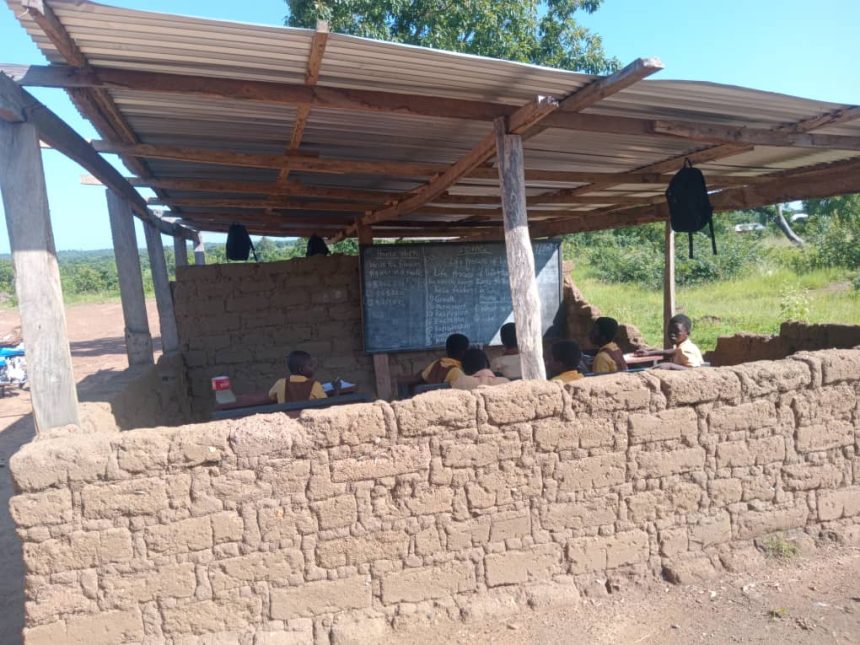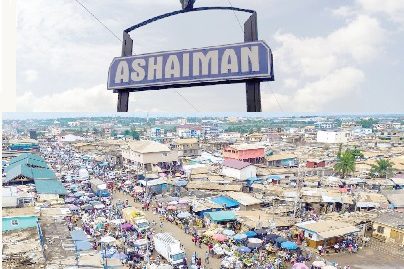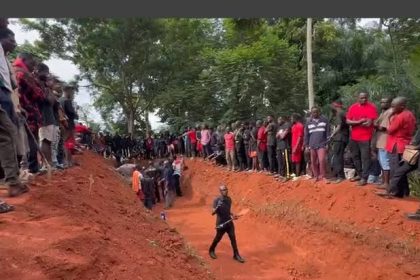Dressed in a torn yellow shirt with a matching pair of brown shorts, little Desmond walked with excitement on a bright Monday morning to school.
Squeezed into a dual desk meant for two but holding four pupils, with his books tucked in a black polythene bag, he looked eager to learn. Beside him sat eight-year-old Jocelyne, clad in a patched brown dress and worn slippers, sharing another overcrowded desk with three classmates.
These children reflect the struggles of more than 200 pupils in Dabillipuo and nearby communities who defy poverty, inadequate infrastructure, and unsafe classrooms to pursue education.
A School of Sacrifice
Dabillipuo, a remote farming community in the Wa East District, established its own primary school in 2007 with grass structures and volunteer teachers funded through community contributions.
In 2011, the government absorbed the school and posted professional teachers, giving the community hope for better access to education. Later, residents built a mud structure to serve children from nearby villages who otherwise had to travel long distances to the nearest school at Kpaglahi.
Currently, the school has over 200 learners from Kindergarten to Basic Four, supported by five teachers. However, its classrooms are unsafe, with cracked walls, broken roofs, stagnant water, and hanging boards that force the school to close whenever it rains.
Furniture is also inadequate. Many pupils carry kitchen stools from home daily or crowd onto the few available desks.
Community Concerns
Community members describe the building as a “death trap,” unfit for 21st-century education.
Mr. Andrews Dari Dagil, Chairperson of the School Management Committee (SMC), told the GNA that though the structure endangered their children’s lives, parents still risked sending them there because of the importance they attached to education.
“We want our children to become better than us because we never had the opportunity to be educated,” he said.
But some parents are withdrawing their children due to the hazardous structure and frequent contributions to patch it up. Children whose families can afford bicycles attend school in Kpaglahi, while others are simply out of school.
A Long Appeal for Support
Despite repeated assurances, the Wa East District Assembly has yet to construct a proper classroom block.
“We are appealing to the government and benevolent individuals to come to our aid. We need a befitting classroom block for our children,” Mr. Dagil pleaded.
Dr. Godfred Seidu Jasaw, Member of Parliament (MP) for Wa East, also appealed for urgent intervention, noting that without a proper school block, the over 200 pupils would be forced out during the rainy season.
District Chief Executive (DCE) Mr. Adamu Sayibu acknowledged the dire situation but attributed the delay to financial constraints. He said the Assembly was exploring funding options and also called on benevolent individuals and organisations for support.
The Bigger Picture
Ghana has made significant strides in education. According to Africa Education Watch, primary school enrolment rose from 2.58 million in 2001 to 4.77 million in 2023, with completion rates improving steadily.
However, infrastructure gaps remain a major cause of school dropouts. Government figures from 2021 revealed that one million children aged 4–18 had never attended school, while 400,000 others had dropped out. Many of these cases are linked to poor or absent school facilities, especially in deprived rural areas like Dabillipuo.
Education and the SDGs
The United Nations Sustainable Development Goal (SDG) 4 mandates governments to ensure inclusive and equitable quality education by 2030. Targets include universal completion of free primary and secondary education and access to quality early childhood development.
A proper school in Dabillipuo would not only improve enrolment and retention but also contribute to Ghana’s progress toward achieving SDG 4.
The Way Forward
The plight of Dabillipuo’s children is a stark reminder of inequalities in Ghana’s education system. While statistics show progress, children in rural areas still risk their lives daily for education.
The Wa East District Assembly, Ministry of Education, and GETFund must move beyond promises and act urgently. Development partners, NGOs, and corporate organisations should also channel part of their resources into supporting rural schools.
Such interventions would ease the burden on parents, give children a safer environment to learn, and secure a brighter future for communities like Dabillipuo.
Until then, these children will continue to brave hazardous conditions for the chance to learn — a situation that demands urgent action, for, as the sages say, a stitch in time saves nine.
GNA






